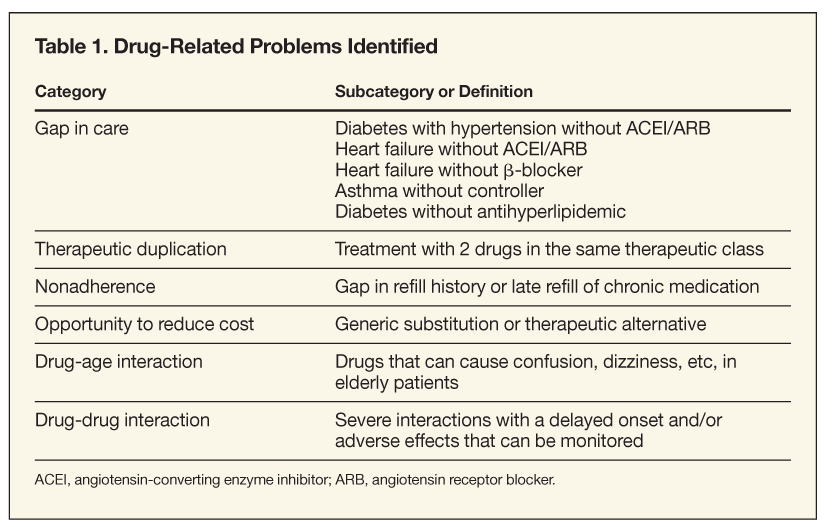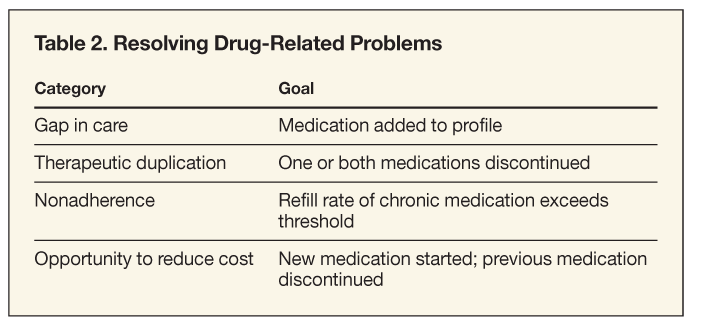- Clinical Technology
- Adult Immunization
- Hepatology
- Pediatric Immunization
- Screening
- Psychiatry
- Allergy
- Women's Health
- Cardiology
- Pediatrics
- Dermatology
- Endocrinology
- Pain Management
- Gastroenterology
- Infectious Disease
- Obesity Medicine
- Rheumatology
- Nephrology
- Neurology
- Pulmonology
Evolution of a Medication Therapy Management Program
Since the 2006 launch of the Medicare Part D prescription drug benefit, the Centers for Medicare & Medicaid Services (CMS) has required all Part D sponsors, including Health Net, to offer free medication therapy management program (MTMP) services to members at high risk for drug-related problems.
The involvement of clinical pharmacists and a focus on continuous improvement by a health plan have resulted in more targeted medication therapy management program (MTMP) services for Medicare beneficiaries. Guidelines of the Centers for Medicare & Medicaid Services (CMS) state that to qualify for MTMP services, members must have multiple chronic diseases, take multiple chronic medications, and have an anticipated annual drug spend of more than $4000.1
Health Net is a publicly traded managed health care company that provides insurance benefits to approximately 6.7 million Americans through group, individual, Medi-care, Medicaid, TRICARE, and US Department of Veterans Affairs plans and programs. Its behavioral health subsidiary, Managed Health Network, Inc (MHN), provides mental health benefits to approximately 6.9 million persons.
In 2005, in support of the company’s program for Medicare beneficiaries, a team of clinical pharmacists from Health Net Pharmaceutical Services (HNPS) interpreted the initial CMS qualification guidelines for its MTMP to provide services to at-risk members with 3 or more chronic diseases (including hypertension, heart failure, asthma, chronic obstructive pulmonary disease, diabetes, hyperlipidemia, and depression) who take 5 or more medications regularly and have a quarterly drug spend of at least $1000.
The Health Net MTMP has evolved into a program that provides a comprehensive picture of a member’s health by actively involving the members, their physicians, HNPS pharmacists, and other Health Net professionals.
Health Net MTMP 2006-2007
At the program’s inception, and as allowed by CMS guidance, the HNPS pharmacists used an opt-in enrollment method to identify members who qualified for the MTMP services and sent letters inviting them to call to begin receiving these services. Shortly after the first round of letters was received, however, fewer than 1% of those members called. It quickly became apparent that this enrollment method would not entice many members to join.
To encourage more participation, the pharmacists identified the high-risk members (those for whom antidementia, antipsychotic, or antiplatelet medications or at least 10 drugs for chronic illnesses had been prescribed) and switched their enrollment method to opt-out. The pharmacists conducted detailed drug regimen reviews of patient histories and faxed documentation on any therapeutic care gaps that they discovered to the patients’ physicians. They also made outbound phone calls asking members if they would like additional free services, such as drug regimen reviews and consultation with a pharmacist, or behavioral health counseling with an MHN clinician on disease management, drug or alcohol abuse, smoking cessation, weight management, or elder-care assistance.
This hybrid opt-in/opt-out enrollment method increased the participation rate to 10%. However, 56% of those declined further services. Still, outcomes from this early phase of the program were promising2 because the pharmacists resolved more than 95% of the drug-related problems identified for those who were active MTMP participants during that time.
Health Net MTMP 2008
The pharmacists sought to increase their program’s participation rate further for 2008 by switching to an opt-out enrollment method for all members who qualified. This swelled the rate to 90% of the plan’s beneficiaries who were eligible for MTMP services. According to the CMS, 45% of Part D sponsors used a hybrid opt-in/opt-out enrollment method and 65% of eligible members actively participated in MTMPs on average.3

In order to accommodate the increase in participation, the pharmacists modified both their outreach and their data manipulation methods. Instead of sending a basic invitation in the letters followed by phone calls, the pharmacists added specific information to the letters that incorporated recommendations from each member’s drug regimen review. (Table 1 lists examples of the types of drug-related problems identified.)
The pharmacists also worked with a software development company to derive the algorithms that identify the drug-related problems. RxCellent Care, the proprietary in-house software created for a Web-based interface, provides a work queue of member histories to review; imports pharmacy claims, provider data, and member demographics; and enables the pharmacists to validate the drug-related problems while deciding which to include in the letters. Once a pharmacist selects the drug-related problems, the software generates a letter with a phone number for the member to call and discuss the recommendations with a pharmacist, and then sends it to a queue for nightly printing and mailing.
The call volume resulting from these letters was fewer than 5% of the members who were eligible for MTMP services. Most of those callers had basic benefit questions that pharmacy technicians answered. Members with more complex questions were transferred to pharmacists who provided consultations and, as needed, physician interventions via fax or phone.

Methods for Results
As the software generates the letters, it also populates a database of all drug-related problems that are pending resolution (Table 2 lists examples). The MTMP software tracked goal achievement for the following drug-related problems identified in 2008: 50,000 examples of nonadherence; 44,000 opportunities to reduce cost; 20,000 gaps in care; and 3000 therapeutic duplications. Enhancements are under way to fully automate the goal-resolution process.
The software evaluates pharmacy claims for 6 months after completion of the drug regimen review, which provides members with sufficient time to discuss any recommendations with their physicians. The software calculates trends in medication regimen adherence and ensures that changes in therapy meet rigorous standards. For example, if the pharmacists recommend that a member switch from esomeprazole to omeprazole, the software ensures that the member stops the triggering medication (esomeprazole) and has an adequate trial of the alternative drug (omeprazole). Otherwise, the pharmacists do not consider the goal to have been achieved.
The software also calculates monthly changes in average drug costs as a result of the interventions achieved, enabling Health Net to measure the financial impact of increasing adherence, filling care gaps, switching to lower-cost alternatives, and eliminating therapeutic duplications. (Because of new standards built into the software’s logic to determine outcomes, total 2008 results will not be available until later this year.)
Future Enhancements
As discussed at a July 28, 2008, Academy of Managed Care Pharmacy roundtable meeting,4 the CMS released new operational and reporting requirements for MTMPs, effective 2010.5 Some health plans will need to lower their minimum drug threshold to 8 medications, change their numbers and categories of disease that are used to determine eligibility, and lower the drug spend threshold to $3000 per year. For most plans, these changes will result in more members becoming eligible for their MTMP services.
The CMS also is requiring that all plans use an opt-out enrollment method, perform comprehensive drug regimen reviews, offer one-on-one consultations, and complete quarterly follow-ups with beneficiaries. Because Health Net has already made changes along these lines, the new CMS directives will have minimal impact.
The CMS requires Medicare Part D sponsors to continually monitor outcomes and revise their MTMPs based on internal findings; this promotes research and innovation. As Part D enters its fourth year, health plan experience with MTMPs will provide the CMS with much needed insight into the impact of different service models. Plans must continue to balance administrative costs and keep benefits affordable while providing MTMP services to those who qualify. To date, a consensus statement6 and validation study7 have determined what the health care community deems “sound medication therapy management.” But comparative data for different interventions, services, and practice types still are necessary to determine which MTMPs provide the most benefit for the most members while keeping costs in check, thus defining best practice.
References:
References
1. Federal Register. 2005;70:4540-4541.
2. Gedey RJ, Giordano A, Holden C, et al. Overview of a comprehensive medication therapy management program (MTMP) with preliminary outcome data. Poster presented at: California Society of Health-System Pharmacists Seminar 2006 Poster Session; October 14, 2006; Sacramento, CA. Abstract D6.
3. Centers for Medicare & Medicaid Services. Medicare Part D Medication Therapy Management (MTM) Programs. 2008 Fact Sheet. http:// www.cms.hhs.gov/PrescriptionDrugCov Contra/Downloads/MTMFactSheet.pdf. Revised March 19, 2008. Accessed June 4, 2009.
4. Balfour DC 3rd, Evans S, Januska J, et al. Medicare Part D-a roundtable discussion of current issues and trends. J Manag Care Pharm. 2009;15(1, suppl A):S3-S9.
5. Center for Drug and Health Plan Choice. Centers for Medicare & Medicaid Services. 2010 Call letter. http://www.cms.hhs.gov/Prescription DrugCovContra/Downloads/2010CallLetter. pdf. Published March 30, 2009. Accessed June 4, 2009.
6. Consensus Document Workgroup. Sound medication therapy management programs. J Manag Care Pharm. 2006;12:S2-S15.
7. Academy of Managed Care Pharmacy. Sound medication therapy management programs, version 2.0 with validation study. J Manag Care Pharm. 2008;14:S2-S42.
